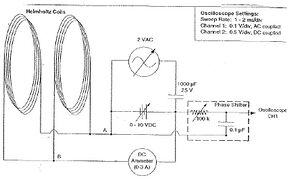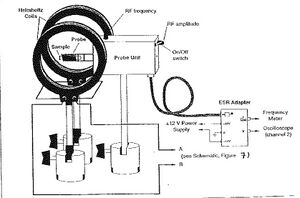Physics307L:People/Dougherty/Notebook/071112
Cary M. Dougherty 18:36, 20 November 2007 (CST)
Electron Spin Resonance
Linh and I tackled the Electron Spin Resonance. The entire lab was simple except for the setup which was fairly complicated. After the setup we were able to take date a very easily and were able to get decent data.
The purpose of the experiment is to observe electrons subject to and outside magnetic field. then calculate the famous [math]\displaystyle{ g_s }[/math] factor.
Setup/Procedure
The setup for this experiment was complicated but after that it was very simple. The lab manual was the only tool we had in starting this experiment.
Last Year's Manual See pages 54-63
Although it may look complicated, once the circuit is set up correctly it is simple afterwards.



As seen in Fig. 1 from the lab manual, the circuit is complicated, but if broken into pieces it is easier. First, the coils are connected in parallel. Second, the DC power and the Transformer from the Variac are also connected in parallel. Next, the capacitor is connected (with correct polarity) in series with the DC power and the transformer. Lastly, one of the ends of the coil goes directly into the phase shifter and into the negative side of the DC power, while the other side of the coil goes through an anmeter and into the positive side of the DC power. The phase shifter is connected directly into channel 1 of the oscilliscope.
Half way and next is the probe and ESR adapter.
As Seen in Fig. 2 of the lab manual, the ESR is plugged directly into channel 2 of the oscilliscope and also into the frequency meter.Then it is also plugged directly into the probe. Also we hooked up the ESR to the positive end of a power supply and to a negative end of a different power supply. then connected the 2 power supplies together by the open positive and negative connections.
Also looking at Fig. 2, we can see a coil connected to the probe with a sample in it. We used 3 different types of coils with the sample during our experiment.
We then placed the coils a radius apart and placed the probe in between. We also made sure the coils were as parallel as possible by eye.
Channel 1 of the oscilliscope read the magnetic field of the coils while the probe was in the center. While channel 2 read the RF frequency within the probe.
While the probe was in between the coils we adjusted the curren and/or the frequency until we saw small spikes occur in a patter. Then we calibrated the oscilliscope so that the spikes viewed, see Fig. 3, were on the zero line of the scope. After that we used the phase shifter to sync the magnetic field of channel 1 with the spikes viewed on channel 2. (refer to lab manual because spikes may look different with each coil.) Once we had the spikes and mag. field symmetric, we took our data with different frequencies, and then used the other 2 coils and did the same.
Equipment
- type w5mt3 variac autotransformer
- fluke 111 true rms multimeter
- homemade transformer
- homemade phase shifter
- soar model ps-3630 dc power supply
- 2x's leybold didactic gmbh helmholtz coils n=320 diam=.15m
- 514 55 esr-grundgerat esr basic unit
- tektronix tds 1012 oscilloscope
- 514 56 esr addapter
- HP 721A power supply x2
- dpph electron source
Data
for the first 2 coils, we had not calibrated the scope so the spikes were at zero. this is crucial to read the correct frequency and current. so the data i will use for my data analysis will come from round 2 of the first 2 coils and the regular data from the last coil.
Small Coil
range 75-130mhz
A
Current in Coil 1.016A
Frequency 75mhz
Freq Ch1 60mhz
Freq Ch2 65mhz
Round 2
Freq: 75mhz
Current: 1.159 A
B
Current in Coil 1.288A
Frequency 90mhz
Freq Ch1 60mhz
Freq Ch2 152mhz
Round 2
Freq:90mhz
Current:1.385 A
C
Current in Coil 1.47A
Frequency 105mhz
Freq Ch1 60.1mhz
Freq Ch2 170.2mhz
Round 2
Freq: 105mhz
Current: 1.620 A
D
Current in Coil 1.669A
Frequency 120mhz
Freq Ch1 60mhz
Freq Ch2 187mhz
Round 2
Freq:120mhz
Current: 1.850 A
E
Current in Coil 1.096A
Frequency 80mhz
Freq Ch1 60mhz
Freq Ch2 163mhz
Round 2
Freq:80mhz
Current: 1.231A
Medium Coil
range 30-75mhz
A
Current in Coils 1.089A
Frequency 50Mhz (meter)
freq ch1 60.1 mhz
freq ch2 273 mhz
Round 2
Freq:50mhz
Current:.770A
B
Current in Coils .411A
Frequency 30Mhz (meter)
freq ch1 60.1 mhz
freq ch2 125 mhz
Round 2
freq:30mhz
Current: .446
C
Current in Coils .690A
Frequency 40Mhz (meter)
freq ch1 60.1 mhz
freq ch2 130 mhz
Round 2
freq: 40mhz
current:.600A
D
Current in Coils 1.043A
Frequency 60Mhz (meter)
freq ch1 60.1 mhz
freq ch2 141 mhz
Round 2
freq: 60mhz
current: .914
E
Current in Coils 1.18A
Frequency 70Mhz (meter)
freq ch1 60.1 mhz
freq ch2 135 mhz
Round 2
freq:70mhz
current: 1.130
Large Coil
range 13-30mhz
A
freq=13 mhz
Current-.238A
ch1 60mhz
ch2 undef
B
freq 17 mhz
current- .247 A
C
freq 21 mhz
current: .337 A
D
freq 25
Current: .356 A
E
freq 28
current: .481
Data Analysis
SJK 22:28, 9 December 2007 (CST)

This is pretty hard to follow without the Excel sheet! But good work you and Linh blazing the trail on this apparatus.
- [math]\displaystyle{ h\nu = g_s \mu_B B \, }[/math]
- [math]\displaystyle{ B = {\left ( \frac{4}{5} \right )}^{3/2} \frac{\mu_0 n I}{R} }[/math]
- [math]\displaystyle{ I\; }[/math] = coil current, in amperes
- [math]\displaystyle{ R\; }[/math] = coil radius, in meters = 0.135 m
- [math]\displaystyle{ n\; }[/math] = number of wire loops in one coil = 320
- [math]\displaystyle{ \mu_0\; }[/math] = is the permeability constant ([math]\displaystyle{ 1.26 \times 10^{-6} Tm/A }[/math])
- [math]\displaystyle{ \mu_B\; }[/math] = [math]\displaystyle{ 9.2740 \times 10^{-24} J T^{-1} }[/math]
- [math]\displaystyle{ \nu\; }[/math] = frequency
- [math]\displaystyle{ g_s\; }[/math] = constant
- [math]\displaystyle{ h\; }[/math] = planck's constant [math]\displaystyle{ 6.626 \times 10^{-34} J s }[/math]
Small Coil
A
[math]\displaystyle{ B }[/math] = 2.477*10^-3 T
[math]\displaystyle{ g_s }[/math] = 2.163
B
[math]\displaystyle{ B }[/math] = 2.959*10^-3 T
[math]\displaystyle{ g_s }[/math] = 2.172
C
[math]\displaystyle{ B }[/math] = 3.462*10^-3 T
[math]\displaystyle{ g_s }[/math] = 2.167
D
[math]\displaystyle{ B }[/math] = 3.954*10^-3 T
[math]\displaystyle{ g_s }[/math] = 2.169
E
[math]\displaystyle{ B }[/math] = 2.631*10^-3 T
[math]\displaystyle{ g_s }[/math] = 2.173
Medium Coil
A
[math]\displaystyle{ B }[/math] = 1.65*10^-3 T
[math]\displaystyle{ g_s }[/math] = 2.171
B
[math]\displaystyle{ B }[/math] = 9.531*10^-4 T
[math]\displaystyle{ g_s }[/math] = 2.249
C
[math]\displaystyle{ B }[/math] = 1.282*10^-3 T
[math]\displaystyle{ g_s }[/math] = 2.229
D
[math]\displaystyle{ B }[/math] = 1.953*10^-3 T
[math]\displaystyle{ g_s }[/math] = 2.195
E
[math]\displaystyle{ B }[/math] = 2.415*10^-3 T
[math]\displaystyle{ g_s }[/math] = 2.071
Large Coil
A
[math]\displaystyle{ B }[/math] = 5.086*10^-4 T
[math]\displaystyle{ g_s }[/math] = 1.826
B
[math]\displaystyle{ B }[/math] = 5.279*10^-4 T
[math]\displaystyle{ g_s }[/math] = 2.301
C
[math]\displaystyle{ B }[/math] = 7.202*10^-4 T
[math]\displaystyle{ g_s }[/math] = 2.083
D
[math]\displaystyle{ B }[/math] = 7.608*10^-4 T
[math]\displaystyle{ g_s }[/math] = 2.348
E
[math]\displaystyle{ B }[/math] = 1.028*10^-3
[math]\displaystyle{ g_s }[/math] = 1.946
standard error of the mean
- [math]\displaystyle{ s = \sqrt{\frac{1}{N-1} \sum_{i=1}^N (x_i - \overline{x})^2} }[/math]
s = 0.0171181757
- [math]\displaystyle{ SE = \frac{s}{\sqrt{N}} }[/math]
[math]\displaystyle{ SE }[/math] = 0.004419894
[math]\displaystyle{ g_s }[/math]
[math]\displaystyle{ g_s }[/math] = 2.1509 +/- 0.00442